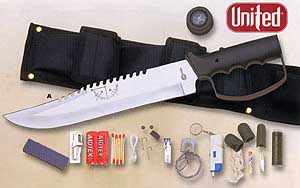Featured Member Video
How to stabilize scales, the easy way.More Videos by Camp10
View larger or ask the author a question.
View all wilderness survival videos
Recent Forum Posts 
| Thread Title | Replies |
| commercial manager salary uk | 2 |
| проститутки кантем... | 0 |
| SAD that this forum........DIED. | 8 |
| best | 0 |
| .......... | 2 |
| weather | 0 |
| AR Pistol Notice | 18 |
| What "ONE" Thing do you h... | 0 |
| "WAREAGLE" Wherefore art-... | 0 |
| Solar Eclipse April the 8th | 3 |
Come Join the Discussion Today!
Our site has been mentioned in:
U.S. News and World Report
Best of the Web - Site of the Week 8/6/01
Discovery Channel Canada
One Week in the Wilderness
USA Today
Hot Sites 08/08/2005
Making Your Own Fish Food
Some people who get involved with aquaponics are interested in creating a complete natural cycle, which includes their source of fish food. This may not be the best approach for the novice since you have enough to deal with in the first place with a new system. But if your arrangement is small enough or you're ambitious enough, you can add this into the mix.
First, find out exactly what your species of fish eat. Feeding carnivores a diet of plant material isn't going to do you any good, especially if you want to keep your fish population in shape for breeding.
Herbivores can be fed a variety of plant foods, with duckweed coming out on top in popularity in the aquaponics world. Duckweed is that tiny-leafed plant that floats on the surface of pond water. You can collect your own starter batch from a local pond if you want but many pond supply companies will offer it for sale to get a "cleaner" sample to start with.
Add another tank for your duckweed, and just keep the water aerated to have a thriving ecosystem of growing duckweed. A shallow tank works just fine, just few inches in depth would do. Harvest it with a fine mesh net, and you have your own fish food. You could have it grow right on the surface of your fish tank, but you can't control feeding that way and the floating plants can raise problems with your pumps.
For carnivores or omnivores, you'll need some insects or worms to join the party. This can be a little tougher to manage on your own. A common approach is to raise black soldier fly (BSF) larvae as fish food. They are small worms or maggots, and they eat pretty much any food waste you have around the kitchen.
These grubs are used as reptile food as well, so they can be purchased at many large pet stores or through a reptile supply house. The generally idea is that you keep a container of food scraps, and allow your maggots to live there. Use them as food, except allow a few of them to mature into adult flies so that they can breed and lay more eggs to keep the cycle going. That can provide an ongoing supply of grubs for your system. Complete details can be found online for raising BSF yourself.
Ultimate Survival Knife & Kit |
List Price: 61.99 Our Price: 39.95 |
This 15 inch survival knife with drop point blade features a thick quality stainless steel blade with serrated top edge. Textured and ribbed solid metal handle and guard. Nylon sheath. Survival kit includes a hollow grip with a compass top to store items within the knife itself, as well as additional pouches on the sheath to hold the rest. Complete survival kit. Click Here to Buy the Survival Knife Now. |
|

